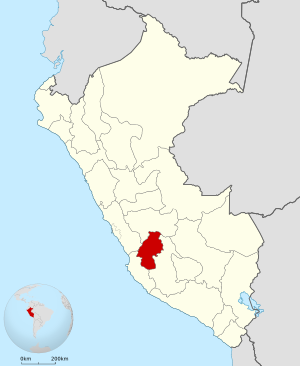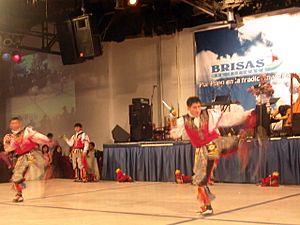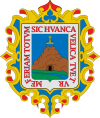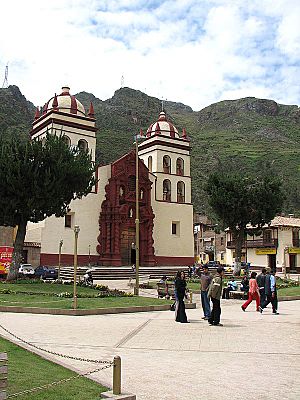Department of Huancavelica facts for kids
Quick facts for kids
Department of Huancavelica
|
|||
|---|---|---|---|

Landscape near Huancavelica
|
|||
|
|||

Location of the Department of Huancavelica in Peru
|
|||
| Country | Peru | ||
| Subdivisions | 7 provinces and 94 districts | ||
| Capital | Huancavelica | ||
| Area | |||
| • Total | 22,131.47 km2 (8,545.01 sq mi) | ||
| Population
(2017)
|
|||
| • Total | 347,639 | ||
| • Density | 15.707904/km2 (40.68328/sq mi) | ||
| UBIGEO |
09
|
||
| ISO 3166 code | PE-HUV | ||

Huancavelica is a special area, like a state or region, in the country of Peru. It covers a large area of about 22,131 square kilometers. In 2017, about 347,639 people lived there. The main city and capital of this region is also called Huancavelica.
The Huancavelica region shares its borders with other parts of Peru. To the west, it's next to Lima and Ica. To the north, you'll find Junín, and to the east, it borders Ayacucho.
Contents
Provinces of Huancavelica
The Huancavelica region is divided into seven smaller areas called provinces. Each province has its own main city, which is called its capital. Think of provinces like counties or districts within a larger state.
Here are the provinces and their capital cities:
- Acobamba Province (Capital: Acobamba)
- Angaraes Province (Capital: Lircay)
- Castrovirreyna Province (Capital: Castrovirreyna)
- Churcampa Province (Capital: Churcampa)
- Huancavelica Province (Capital: Huancavelica)
- Huaytará Province (Capital: Huaytará)
- Tayacaja Province (Capital: Pampas)
The most important cities in the region are Huancavelica, Pampas, and Lircay. There are also many smaller towns and villages. For example, Querco in Huancavelica is a lovely small town. Most people living there are farmers. They raise animals like cattle, sheep, pigs, horses, llamas, goats, chickens, and donkeys.
People and Languages
Most of the people living in the Huancavelica region are indigenous people who are descendants of the ancient Quechua culture.
Languages Spoken
According to a census from 2007, the main language learned by most people in Huancavelica is Quechua. About 64% of the residents learned Quechua first. The type of Quechua spoken here is called Chanka Quechua. The second most common language is Spanish, spoken by about 35% of the people.
Education in Huancavelica
The main university in the region is the National University of Huancavelica. It has different campuses in cities like Pampas, Lircay, Acobamba, and Castrovirreyna, offering education to students across the region.
Health Services
The Huancavelica region has two main hospitals. One is located in the city of Huancavelica, and the other is in Pampas. Besides these hospitals, many towns also have smaller clinics and medical posts to help people with their health needs.
Getting Around
The region is connected to its neighboring areas by national roads. Most of these roads are paved, making travel easier. There are also local roads that help people travel between the towns and villages within Huancavelica. For longer journeys, Huancavelica has a train service that connects it with the city of Huancayo.
Famous People from Huancavelica
- Lina Medina: She is known as the world's youngest mother.
Regional Government
The head of the Huancavelica region is the Governor. From 2015 to 2018, the Governor was Rubén Alva Ochoa. The Governor is responsible for leading the region and making important decisions for its people.
See also
 In Spanish: Departamento de Huancavelica para niños
In Spanish: Departamento de Huancavelica para niños
- Aknuqucha
- Chunta mountain range
- Chuqlluqucha
- Inka Wasi
- Urququcha
- Warmiqucha





